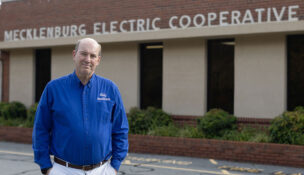Recycle, repurpose, reuse
Landfill industry finds profit in the old mantra of tree huggers
Tim Loughran //March 28, 2014//
Recycle, repurpose, reuse
Landfill industry finds profit in the old mantra of tree huggers
Tim Loughran //March 28, 2014//
Andy Warren needs to buy old roofing shingles.
The former Chesapeake firefighter quit that career six years ago “after seeing what people were throwing away … and thinking I could make some money from that.” Warren started Tidewater Green, a company that buys construction demolition debris that he reformulates into component products and resells.
Roof shingles and scrap wood are his raw materials. The wood is reprocessed and sold to burn for fuel. He grinds up old roofing material and sells the asphalt and fiberglass remnants to paving companies as additive to the aggregate those companies use for new roads and driveways.
Warren says his company’s revenue continues to grow at an average of 12 to 15 percent a year. But he is fighting rising competition from landfills and other recycling companies in Hampton Roads that are trying to buy the same types of raw materials he needs to stay in business.
“There’s so much demand, I can hardly keep up with it,” he says, and quickly pleads, “I really need more shingles.”
Since peaking in 2004 at 27 million tons, the volume of garbage and trash managed by Virginia’s hundreds of solid-waste companies fell to 20.2 million tons during 2012. That was the lowest total since 1998, the year before a prolonged public spat then-Gov. Jim Gilmore had with New York City Mayor Rudolph Giuliani over the amount of trash that Virginia landfill companies were getting from the Big Apple.
Company owners, industry executives and Department of Environmental Quality (DEQ) officials attribute the dramatic 25 percent decline during the past nine years to a unique marketplace dichotomy.
The Great Recession clobbered building activity and consumer demand for new products, so there was much less trash for construction companies, factories, households and retail businesses to throw away.
At the same time, cost-conscious manufacturers, builders and service companies have developed technologies that make developing new products from recycled materials more affordable than ever.
Increased demand for recycled materials has “doubled” that business line for industry giant Waste Management Inc., according to Jim Marcinko, the company’s director of operations for recycling and waste diversion in Virginia, West Virginia, Maryland and western Pennsylvania.
He declines to provide specific revenue information or current prices for the recovered and recycled materials. Nonetheless, Marcinko says, “we’ve seen commodity values increase considerably in the last five years.”
And unlike competitors who have not changed their ways, he says: “Instead of seeing a huge pile of trash, we see a big pile of opportunity.”
So does Peter Van der Linde, another aggressive recycling entrepreneur, who started a company serving the Char-lottesville area in 2008.
When he launched the business in the depths of the recession, he says, “I was lucky to find any buyer for my materials. Now they find me. They’re beating my door down.”
‘Narrowing of the playing field’
Jeffery A. Steers, director of the Division of Land Protection and Revitalization at the DEQ, says the trend to divert waste from landfills began in the 1980s, as states began to pass laws to comply with Subtitle D of the Resource Conservation and Recovery Act (RCRA) that Congress passed in 1976.
In Virginia, pressure on landfill companies to increase investments in recycling and accept less waste accelerated after the General Assembly passed the law known as HB1205 in 1993, he says.
That law mandated that any existing landfill that did not meet tougher new requirements for construction and monitoring must be closed after it had reached its permitted capacity. The law also said that any landfill expansion after 1993 or new landfill construction could take place only under much stricter conditions.
The Virginia law, Steers says, forced the closure of “a couple of dozen” landfills in Virginia during the past 20 years. Now, he says, there are 55 solid waste landfills licensed to operate by the DEQ.
“Clearly, there has been a narrowing of the playing field,” he says. “The whole idea of simply putting [trash] in a hole in the ground, in a flood plain or by a river was not the ideal way to handle solid waste.”
In recent years, most “landfills recognize waste is a commodity,” Steers says. “A lot of things can be recovered, reused. There is a monetary value to waste, whether it’s municipal solid waste, industrial waste or construction debris … that has helped drive the trend to send less to landfills.”
During the past decade, as demand for recycled materials has grown, landfills routinely bury about two-thirds of what they collect every year, according to data compiled by the DEQ. In 1998, by contrast, landfills reported to the DEQ that they had buried 72 percent of what they collected.
Now that prices for scrap metal like steel, iron and aluminum are climbing steadily and organic material can be burned and sold to energy companies, landfill companies have begun digging up older sections of existing landfills to extract material to earn even more money.
Operators now use this “landfill mining” process to generate additional revenue and empty valuable real estate for future dumping of materials that don’t yet have a resale value. During 2012, the first year that DEQ tracked the practice, landfills across the state reported recovering more than 72,000 tons of reusable material.
In a modern-day reprise of the classic Mark Twain story about the fictional Tom Sawyer’s remarkable ability to convince his friends that they’d have fun doing his chores for him, landfill companies have extended their moneymaking efforts to the curbsides and strip malls of Virginia.
Using their hauling companies, landfill companies have persuaded their household and commercial customers to do some of their work for them — sorting out for separate collection the easiest items to resell, like paper, cardboard, metal and plastic — in the name of keeping the state’s environment clean.
These efforts seem to be working. The DEQ reports the state’s solid waste recycling rate was just 30 percent in 2004. By 2007 that rate was up to 39 percent, and by 2011 it had risen to 43.5 percent. In 2012, the state’s recycling rate slipped to 41.5 percent.
‘Zero waste’ target
Late last summer the Virginia Department of Corrections began dismantling the 900-bed Mecklenburg Correctional Center. It’s the second such demolition undertaken under the DOC’s “zero waste” initiative. The first was the 2010-11 demolition of the old Southampton Correctional Center.
From 12 buildings on 19 acres of land in Southampton, the DOC reported that it sent just 80 cubic yards of debris to a landfill. After transferring an estimated $381,000 in used equipment, appliances and fixtures to other DOC facilities, the agency said it earned $316,000 from the resale of recycled metals and $1.1 million from the sale of crushed concrete.
In Mecklenburg, the goal is to limit what the DOC has to send to a landfill to just 50 tons of demolition debris, or 2 percent of the project’s estimated total, says Tony Parnell, the DOC environmental specialist supervising the project.
Parnell says that with the constant flux in prices that recycling wholesalers are paying for construction debris, it’s still too early to predict accurately how much the DOC eventually will earn from recycling most of what it knocks down. He says the early estimates from potential buyers range around $800,000 for the metal he expects to extract from the site and another $800,000 for the crushed cement, brick and cinderblock.
Fifteen inmates, under the watchful eyes of seven supervisors, worked through the autumn, winter and early spring to remove everything from shelving, glass, bedding, linens, tables, doors, office furniture, kitchen equipment and appliances to light bulbs, lockers, bunk beds, wire, sinks, showerheads and bathroom fixtures.
Total demolition of the first of several buildings was scheduled to begin in mid-March. By the time the project is completed in 2016 the DOC also plans to mine and resell all the many thousands of lead bullets buried in the site’s firing range, used for decades by area police officers.
Parnell is confident he can find buyers for almost everything useable at the site, save some wood debris and different types of insulation material, including fiberglass and Styrofoam. Until recently he had the same concerns about the miles and miles of thin Cat5 telecommunications wire his men had pulled from the first building to be torn down.
“A lot of companies want plain communication cable. My problem was how we were going to strip the coating off all the wire we had without breaking it,” Parnell explains. “But I think I’ve found a new company up near Winchester that will be able to take all my wire, test it and reuse it as is.”

















